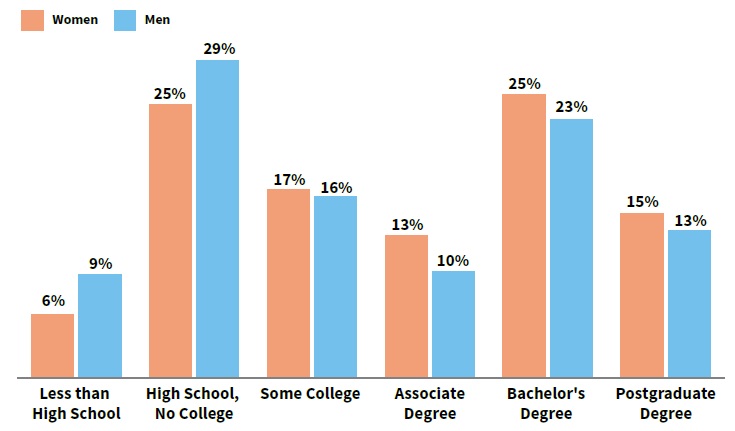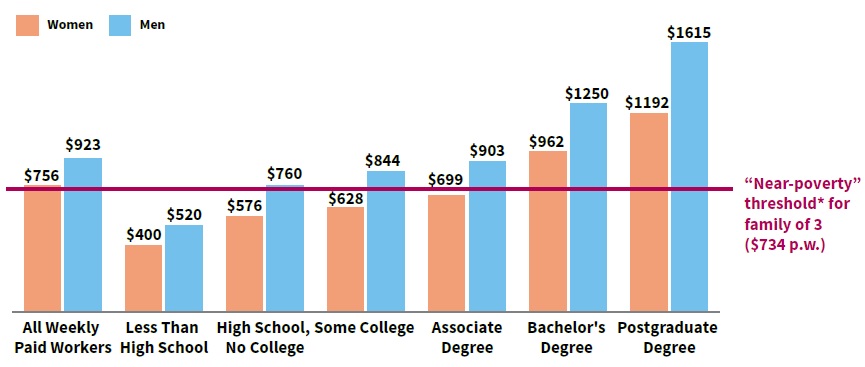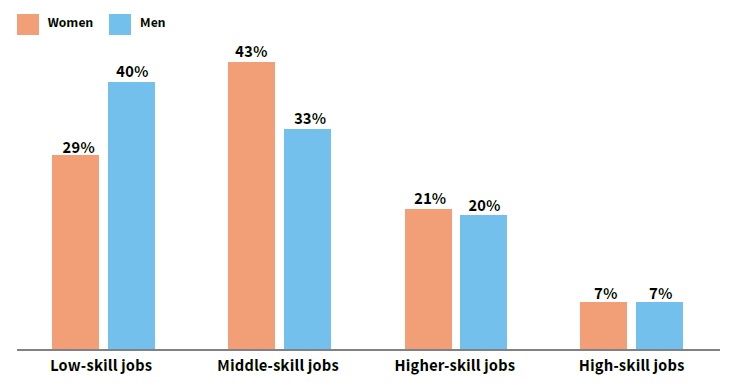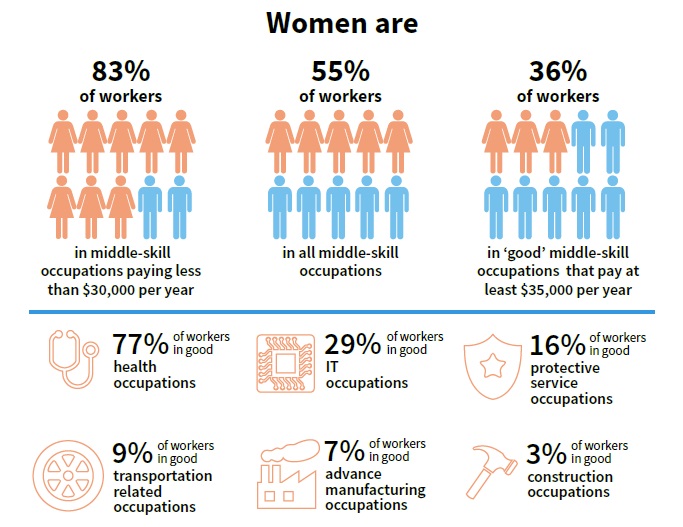Women & Middle-Skill Jobs
Women as an Underutilized Resource to Address Middle-skill Job Shortages
Introduction
Many middle-skill jobs—those jobs that require more than a high school diploma but less than a bachelor’s degree—offer the potential of employment with family-sustaining earnings. Well over a third of all workers (37.2 percent) are employed in these occupations, and over a third (34.4 percent) of all projected job openings are in middle-skill occupations.[1] While not all middle-skill occupations offer family-sustaining wages, the majority of projected job openings (56 percent) are in occupations with median annual earnings of at least $35,000,[2] and may be stepping stones to higher paid careers. Many employers report difficulty finding workers to fill vacancies in middle-skill occupations, including in the key growth sectors of advanced manufacturing; transportation, distribution, and logistics; and information technology (Accenture et al 2014; National Skills Coalition 2014).
Women are only 29 percent of workers in growing middle-skill IT occupations, and they are fewer than 10 percent of workers in growing advanced manufacturing, or transportation, distribution, and logistics occupations.
Women need better access to middle-skill jobs with family-sustaining wages. Women serve as the primary or co-breadwinner in half of U.S. families (Hess et al 2015). As the economy has recovered, millions of workers found jobs, but many of these new jobs pay too little to lift a family out of poverty. Women are the majority of full-time workers whose earnings leave them in near poverty.[3] One in four Hispanic women (24.2 percent) and close to one in five Black women (18.1 percent) work full-time and earn less than $400 per week (U.S. Department of Labor unpublished). Many women are working in middle-skill occupations—indeed, women are over half (55 percent) of workers in occupations that require some college education and on-the-job training but do not pay family-sustaining wages—but they are much less likely than men to work in well-paid middle-skill occupations. Women are 83 percent of workers in middle-skill occupations that pay less than $30,000 per year but they are just 36 percent in growing, middle-skill occupations that pay at least $35,000 per year. Women are only 29 percent of workers in growing middle-skill IT occupations, and they are fewer than 10 percent of workers in growing advanced manufacturing, or transportation, distribution, and logistics occupations.
In the coming decade these occupations will have substantial job openings both from growth and from the coming retirement of many workers who are now in these jobs. If employers are going to successfully fill the skills gaps resulting from retirement, turnover, and employment growth in advanced manufacturing; IT; and transportation, distribution, and logistics; they can ill-afford to ignore the potential talent of women workers.
Women are 83 percent of workers in middle-skill occupations that pay less than $30,000 per year but they are just 36 percent in growing middle-skill occupations that pay at least $35,000 per year.
Targeting women for middle-skill jobs in these sectors makes business sense. Diverse workplaces are more productive (see for example Ellison and Mullin 2014 or Herring 2008). Women are more likely than men to invest in education beyond high school, and thus to have the basic skills and knowledge sets required in middle-skill occupations. Many women already work in occupations that have similar skills, knowledge, and ability characteristics to the occupations employers are seeking to fill, but are lower paid. Although these target middle-skill occupations currently employ only a small minority of women, there is little to suggest that there are not many women who could successfully train for these occupations. Recruiting more women to fill skills gaps in growing middle-skill occupations is a viable, if not necessary, strategy for employers, while for women such occupations present pathways to higher earnings and economic security.
This report provides information intended to facilitate the greater gender integration of good middle-skill jobs. Using an innovative methodology based on the U.S. Department of Labor’s O*Net database of occupational characteristics, this report highlights well-paid occupations with current and projected skill shortages in middle-skill occupations that do not require a bachelor’s degree but pay family-sustaining wages in manufacturing, information technology, and transportation, distribution, and logistics. The report also identifies potential on-ramp occupations in similar fields or with similar characteristics-matching many of the job requirements, attitudes, experiences, and attributes of workers in the target occupation—that employ many women. Because of gendered assumptions of which jobs may be appropriate for women—assumptions held by women themselves, and by employers, trainers, educators, and workforce developers—women in these jobs may not be seen as a logical pool of talent for these growing middle-skill occupations.
Identifying Pathways to Greater Gender Equity in Middle-skill Occupations: A New Methodology
This report is based on an innovative methodology for comparing occupations. It takes growing well-paid target occupations which currently employ few women and identifies potential on-ramp occupations which share many characteristics with the target occupation but have lower median annual earnings and employ many women. This methodology draws on the U.S. Department of Labor’s O*Net database. O*Net describes occupations through 252 individual attributes that captures work organization, the work environment, typical tasks and worker attributes, and the knowledge and skills required. Using O*Net occupational characteristics makes it possible to compare occupations from different fields that initially look very different, but may actually have considerable similarity in what it takes to perform the work. Collected from individual workers as well as from occupational experts, O*Net data include information on the characteristics of workers currently in the job (such as their average educational attainment, occupational interests, work values and styles); on the nature of work in the occupation (difficulty of work activity, tasks, tools, and technologies used, organizational and work context); and the level of experience and training required in the occupation (See Appendix A for a more detailed description of O*Net).[4]
The O*Net database includes general employment data about each occupation but does not do so separately for women and men. To provide a gendered overview of occupations, occupational data from O*Net has been integrated with data from the American Community Survey on total employment, combining five years of data (from 2009–2013) to get a sufficient sample for male and female workers in each occupation. Data on median annual earnings of full-time workers are estimated based on the 2013 Current Population Survey.[5] Our integrated IWPR O*Net database further includes projected job openings and employment growth for each occupation between 2014 and 2024, from the U.S. Bureau of Labor Statistics. Altogether data are available for 473 occupations (see Appendix A).
In a pairwise statistical procedure that compares the values of 252 occupational attributes (described in the appendix), an occupational distance variable is calculated for each occupation in relation to every other occupation in the data set; this variable indicates how much different occupations have in common with each other. For example, of the 473 occupations, the most similar occupation to Welders, Cutters, and Welder Fitters is Engine and other Machine Assemblers with a value of 0.067; the least similar is Chief Executive with a value of 0.286.
An illustration of this circumstance is provided by the recommendation (see Figure 4.2) of cooks as a potential on-ramp occupation for truck drivers.[6] [7] In our immediate mental images, nothing could seem more unlike each other than the chef in her toque and the truck driver rolling down an interstate highway. However, when we score each of these jobs on the 252 O*Net characteristics describing the actual nature and duties of these positions, we find that, overall, cooks are more similar to truck drivers than 70% of the 473 occupations we have analyzed. For example:
- The occupations are very similar to each other in terms of the amount of instruction needed to learn the job; the use of deductive and inductive reasoning; the need to be able to visualize physical arrangements; required command of the English language; the extent to which the occupation satisfies a worker’s “enterprising” occupational interest; the extent to which the work is paced by the speed of equipment; the frequency of exposure to physical hazards; and the extent to which the job involves administrative “paperwork.”
- Where the jobs are very dissimilar, the dissimilarities typically involve relatively limited characteristics (such as the extent to which the job involves sitting rather than standing or involves distance vision rather than near vision), and differences readily addressable through training (such as workers’ knowledge of food production).
Middle-skill occupations almost by definition require some investment in training and education, from individual workers, employers, and the workforce system more broadly. Identifying potential on-ramp occupations that already employ many women may increase the likelihood that the target occupation will be a good fit for women seeking to improve their earnings and maximize their returns on their investment in training.
This report highlights high-growth middle-skill occupations in manufacturing, information technology, and transportation, distribution, and logistics, together with findings on close predominately female occupations that offer “on-ramps” to some of the shortage middle-skill occupations in these promising fields. It also makes the case that implementing promising strategies to integrate women into these good middle-skill jobs can help to reduce gender differences in earnings in the labor market overall, and improve family economic security.
The Gender Wage Gap and Educational Attainment
In 2015, the median earnings for women working full-time, year-round were only 79 percent of men’s median earnings. Women’s lower earnings are not due to lack of educational attainment: women in the workforce are more likely than men to have finished high school, have some post-secondary college qualifications, and to have a 2-year or 4-year degree (Figure 1.1).
Figure 1.1. Women Workers Are More Likely Than Men to Invest in their Education
The Distribution of Workers Ages 25 and Older by Highest Educational Attainment and Gender, 2014

Notes: Workers in the civilian labor force, ages 25 and older. Full-time is defined as 35 hours or more per week.
Source: IWPR analysis Current Population Survey Merged Outgoing Rotation Groups as provided by the National Bureau of Economic Research (http://www.nber.org/cps/)
At each level of educational attainment, women’s earnings are lower than men’s. The median weekly earnings of men with a high school diploma are higher than the median weekly earnings of women with some college or even an associate degree. Even with some college or an associate degree, women’s median weekly earnings for full-time work leave a household of one adult with two children in near-poverty. It takes a bachelor’s degree to lift the median weekly earnings of women out of near-poverty; it takes some college for men’s median weekly earnings to rise to that level (Figure 1.2). Women’s higher educational attainment and lower median earnings for full-time work suggest that something is amiss. Women are pursuing education and training but are less likely than men to be in jobs that pay wages that can make families self-sufficient.
Figure 1.2. Women Need at least a Bachelor’s Degree to Lift their Families out of Near Poverty
Median Weekly Earnings of Full-Time Wage and Salary Workers Age 25 and Older by Sex and Educational Attainment, 2014 Annual Average

Notes: Full-time workers (working at least 35 hours per week) in the civilian labor force. *Near-poverty threshold defined as 200 percent of federal poverty guidelines; in 2014 this ‘near-poverty’ threshold for an adult with two children was $733.58 per week, or annual income of $38,146 (U.S. Census Bureau 2015).
Source: IWPR analysis Current Population Survey Merged Outgoing Rotation Groups as provided by the National Bureau of Economic Research (http://www.nber.org/cps/).
Over half of the gender wage gap is due to the fact that women and men tend to work in different occupations and sectors of the economy (Blau and Kahn 2016). The integration of occupations since the 1960s made a major contribution to earnings increases for women (Hsieh et al. 2013) but since the beginning of the 2000s further occupational integration has stalled, along with further progress in closing the gender wage gap (Blau, Brummund, and Liu 2013; Hegewisch and Hartmann 2014). Occupational gender segregation is particularly pronounced for workers who do not have a bachelor’s degree (Hegewisch and Hartmann 2014).
Middle-skill Jobs and Women’s Earnings
Drawing on the U.S. Department of Labor’s O*Net database, this report classifies occupations into four broad skill levels: low-, middle-, higher-, and high-skill occupations. The O*Net database assesses occupations both by formal educational attainment and on-the-job training and preparation required for a worker to become competent.[8]
- Low-skill: Occupations that require a high school diploma or less, and little to moderate experience on the job (for example waiters/waitresses or security guards).
- Middle-skill: Occupations that require at least post-secondary certification but less than a bachelor’s degree, and moderate to substantial on the job-experience and training, including apprenticeships (for example, nursing and psychiatric aides, teachers’ assistants, carpenters, or firefighters).
- Higher-skilled: Occupations that require a bachelor’s degree, and typically some on-the-job experience (for example accountants, teachers, computer programmers).
- High-skill: Occupations that require postgraduate or professional degrees, and typically some on the-job-experience (for example, librarians, lawyers, and physicians).
Women are more likely than men to work in middle-skill occupations, men are more likely than women to work in low-skill occupations, and men and women are proportionately equally likely to work in higher or high-skill occupations. More than four in ten women (43 percent) compared with one in three men (33 percent) work in middle-skill occupations, while four in ten men (40 percent) and three in ten women (29 percent) work in low-skill occupations (Figure 1.3).
Figure 1.3. Women Are More Likely Than Men to Work in Middle-Skill Occupations
The Distribution of Women’s and Men’s Employment across Occupations by Broad Skill Levels, 2009-2013

Notes: Employment in occupation is five year average 2009-2013.
Sources: IWPR calculations based on IWPR O*Net database (see Appendix A).
While women are 55 percent of all middle-skill workers they are 83 percent of workers in middle-skill occupations that have median annual earnings for full-time work of less than $30,000. In good middle-skill occupations—those that pay at least $35,000 per year and are not declining—women’s share of workers falls to 36 percent.[9] In many of the growing good jobs women’s share of workers is much lower (see Figure 1.4).
Figure 1.4. Women’s Share of Middle-skill Occupations

Notes: * Excludes middle-skill occupations projected to decline. For definition of middle-skill jobs see Appendix A.
Source: IWPR calculations based on IWPR O*NET database.
Women’s concentration in lower paid middle-skill occupations is related to women’s work in predominantly female occupations. Moreover, a high number of middle-skill occupations, particularly those that are better paid, are predominantly male and nontraditional for women. The Workforce Innovation and Opportunity Act of 2014 defines occupations where women are fewer than 25 percent of all workers as a nontraditional occupation for women; and correspondingly a nontraditional occupation for men is one where at least 75 percent of workers are women.[10] Median annual earnings are substantially lower in female-dominated occupations than in more integrated or male-dominated occupations. The median annual earnings for full-time year-round workers in predominantly female middle-skill occupations were $31,985, in middle-skill integrated occupations (where the share of both male and female workers is higher than 25 percent), and in predominantly male occupations (occupations that are nontraditional for women), they were $48,550 (Table 1.1). Workers in middle-skill female-dominated occupations only earn 66 cents for every dollar made by workers in middle-skill male-dominated occupation.[11] This occupational wage gap is in addition to the gender wage gap within each occupation (Hegewisch and Ellis 2015).
Workers in middle-skill female-dominated occupations only earn 66 cents for every dollar made by workers in middle-skill male-dominated occupations.
Table 1.1. Median Annual Earnings and Share of Workers in Predominantly Male, Predominantly Female, and Mixed Middle-skill Occupations

Note: Full-time year-round defined as at least 35 hours per week for at least 50 weeks per year. Earnings adjusted to 2014 real dollars.
Source: IWPR calculations based on IWPR O*NET database (see Appendix A).
Higher earnings in predominantly male occupations are not due to higher educational requirements. Average educational requirements in middle-skill predominantly male occupations are marginally lower than those in predominantly female occupations, and substantially lower than those in integrated occupations.[12] In predominantly male occupations, on-the-job training tends to play a greater role than post-secondary college level qualifications. Becoming a fully-skilled worker through on-the-job training can take several years. In some occupations such pathways are formalized through apprenticeships that provide a formal ‘earning-while-learning’ pathway toward industry-recognized certification in many middle-skill male-dominated technical occupations. Women are fewer than one in ten apprentices in the U.S. (U.S. Department of Labor ETA 2015b).
Gender segregated occupations, and particularly predominantly female occupations, are more common among middle-skill jobs than in low-, higher-, or high-skill occupations but occupational gender segregation is not limited to middle-skill occupations. Of all 473 occupations included in the IWPR O*Net Database, fewer than half are relatively integrated (Table 1.2).
Table 1.2. 473 Occupations by Skill Level and Gender Segregation
Notes: Numbers refer to number of occupations in each skill category, further disaggregated by gender type of occupation. Classification of occupations into gender types is based on full-time, year round workers.
What if just Ten Percent of Women Moved Occupations: A Thought Experiment
The difference in earnings between predominantly female and predominantly male occupations at the same broad skill level (or indeed, at higher skill levels in female-dominated occupations) suggests that women’s earnings could increase if they moved to different occupations. By integrating the O*Net analysis of closeness/distance between occupations (see above) with data on employment, gender, and median annual earnings, we can estimate what would happen if women’s employment was more optimally distributed across the economy. Optimal is defined in two different ways: Goal A is a more even distribution of women across occupations; Goal B is the maximization of women’s earnings. In the illustrative analysis reported here, the number of women moving between occupations is limited to 10 percent of women workers overall and to no more than 50 percent of currently employed women moving out of any individual occupation. Both optimizations assume that there is no change in the earnings in any one occupation, and that no additional workers join the economy. Under the wage optimization strategy, the median annual earnings of women who move would increase by over 50 percent, from $36,779 to $55,860 (based on 2013 earnings levels). The move would translate into a 5 percent increase in earnings of all women. Goal A, the greater integration of occupations, would result in a 27 percent increase of the median annual earnings of the women who move, translating into a 2.5 percent increase of the earnings of all women (see Appendix B Table B1 for full results). Both strategies would see a reduction in the number of women working in the lowest paid occupations (with median annual earnings of less than $25,000).
Realizing such gains in earnings would require investments in training and education for many women moving into new occupations. Under the wage maximizing strategy, average education and on-the-job experience are slightly higher in the post- than in the pre-move occupations; this is not the case under the occupational integration strategy, but of course moving into a middle-skill occupation is likely to require some occupation-specific skills. Yet the pathways identified by this approach generate much higher potential earning gains than traditional career pathways that narrowly focus on one occupational field. Moving from being a library assistant, with median annual earnings of $29,026, to becoming a library technician, with median annual earnings of $32,318, requires a bachelor’s degree and some post-graduate qualifications; investing instead in an associate degree to become a computer user support specialists can lead to a job with median annual earnings of $52,917. Both jobs require substantial interface with computer software, hardware, and databases, and both require being able to communicate with clients and customers.
Higher earnings in predominantly male occupations are not due to higher educational requirements.
Occupational gender segregation is a result of many factors: stereotypes, social values, myths about women’s work and skills, and discriminatory practices in training programs and workplaces (Bergmann 2011; Cotter, Hermsen, and Vanneman 2011; England 2010; 2011). Women’s low numbers in middle-skill technical jobs reduces pressures and innovation in the way work is organized to make it more amenable to modern workers with work-family responsibilities; this in turn makes such jobs potentially less attractive to women—creating a chicken-and-egg barrier to change (Turnbull 2013). It also reflects lack of information about available opportunities (Negrey et al. 2002). Focusing on the similarities between occupations may encourage individual women, and workforce developers advising their clients, to see beyond existing occupational pathways for women and focus instead on those that optimize earnings for a set investment in training and education.
Manufacturing, information technology, and transportation, distribution, and logistics are clear targets for such an approach. Women are a minority of employees in each of these sectors; they are particularly underrepresented in growing well-paid middle-skill occupations. The report will look in turn at well-paid growing occupations in which employers report difficulties in finding workers in each sector and identify occupations that could serve as on-ramps for women to better paying jobs. Information on potential target and on-ramp occupations in other sectors can be found on the “Find a Target Job” page.
[1] IWPR analysis based on IWPR O*Net database and 2014-2024 BLS projections (see Appendix A) of total job openings (resulting from job growth and employee turnover). In 2014, 53.8 million workers were employed in middle-skilled occupations, 37 percent of all workers.
[2] IWPR analysis based on IWPR O*Net database (see Appendix A) and 2014-2024 BLS projections of total job openings in middle-skilled occupations, excluding openings in occupations projected to decline.
[3] Near-poverty is defined as 200 percent or less of the federal poverty threshold; the threshold varies by family type. In 2014, the near-poverty threshold for one adult with one child was $32,634 or $627.58 per week. The near poverty threshold for an adult with two children was $733.58 per week, or annual income of $38,146 (U.S. Census Bureau 2015).
[4] A small number of other studies have systematically analyzed O*Net data (or subsets of it) to identify career paths and occupational change (Abel and Gabe 2010; Alterman et al. 2008; Indiana Department of Workforce Development and Indiana Business Research Center 2011; Johnson, Mermin, and Resseger, 2013) but have not specifically focused on gender differences in occupations.
[5] Earnings data have been updated to 2014 dollars based on the Consumer Price Index Research Series (CPI-U-RS); U.S. Bureau of Labor Statistics <http://www.bls.gov/cpi/cpirsai1978-2014.pdff> (accessed September 2015).
[6] The closeness value for Sales/Truck Drivers and Cooks is 0.89, a lower value that Sales/truck drivers and Bus Drivers (0.90).
[7] Examples of other O*Net based comparisons of skills sets (engineers and nurses, construction managers and convention planners, and firefighters and personal and home care aides) can be found on the iseek careers website of Minnesota State Colleges and Universities <http://www.iseek.org/careers/skillsets.html> (accessed February 9, 2016). See also Figures 2.2 and 4.3.
[8] The O*Net database classifies occupation into five broad Job Zones; see Appendix A for a detailed description. For the purposes of this report, occupations in Job Zone 1 and Job Zone 2 that require high school only and limited on the job training are classified as low-skill. Occupations in Job Zone 2 that require high school only but considerable on-the job preparation/apprenticeships are classified as middle-skilled. Occupations in Job Zone 3 that require a bachelor’s degree have been classified as higher-skilled.
[9] IWPR calculations based on O*Net dataset and Current Population Survey earnings data for 2013, adjusted to 2014 real dollars.
[10] 29 U.S.C. § 3102(7).WIOA SEC.3 (37)
[11] IWPR calculation based on Table 1.2.
[12] IWPR calculation based on O*Net database; data not shown.

